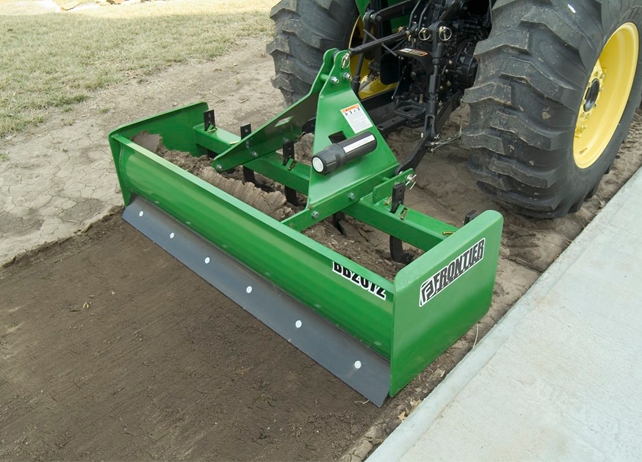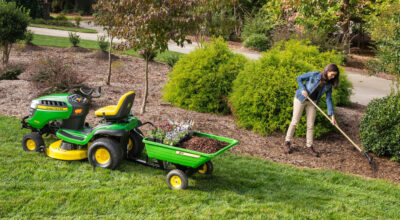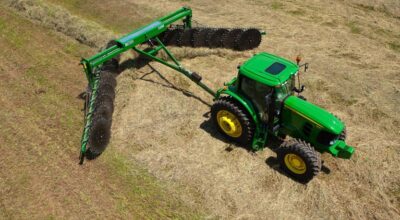
What is a Box Blade?
Box blades for tractors are primarily used for leveling, grading, backfilling, or spreading materials like gravel or soil. They typically attach to the back of tractors and provide operators with a versatile implement that can be used for many applications.
What is a Box Blade Used For?
A box blade can be used for a variety of jobs around your property. That said, box blades are most commonly used for grading, leveling, ruts removal, breaking up compacted ground, and backfilling.
What Does a Box Blade Look Like?
A box blade for a tractor looks like a 3-sided metal box and includes front and rear scraping blades that are located on the bottom of the rear panel. Box blades for tractors use scarifiers (angled metal teeth) to dig into the ground and break up the dirt or soil so it can be shaped to match the operator’s preference.
How is a Box Blade Used?
Now that we have a better understanding of what a box blade is, let’s take a look at how it’s used (Remember, working with a box blade takes practice and it may take a few uses before you start becoming fully comfortable with operating).
- Educate Yourself Before Working with a Box Blade
- Adjust the Top Link
- Get Scarifiers in Position
- Level the Box Blade
- Run Tractor Over Newly-Filled Holes
1. Educate Yourself Before Working with a Box Blade
Before you start working with a box blade, take the time to read through the Operator’s Manual. By doing so, you’ll gain a better understanding of the equipment, and most importantly, how to operate it safely.
2. Adjust the Top Link
When taking on a scraping project, start by adjusting the top link so the cutting blades (front and rear) are touching the ground. Doing so will promote a basic smoothing action. If you want your box blade for a tractor to scrape more aggressively, simply shorten the top link so the blade is angled forwards.
3. Get Scarifiers in Position
If you have bumps on your surface that you want to flatten, put the scarifiers in the locked position and angle the box blade forward just a bit. The scarifiers will break the ground apart and after this is done, they should be pulled back up to prepare for smoothing out the surface.
4. Level the Box Blade for your Tractor
After the ground has been worked over by the scarifiers, level the box blade on both sides and lengthen the top link so the blades are angled slightly upwards. Set the 3-point to the “float” position and start pulling the implement along the ground. The rear blade will gently smooth the surface as you move along.
5. Run Tractor Over Newly-Filled Holes
If low spots have been filled with loose material, it’s a good idea to drive over the area a few times with the tractor’s tires to ensure it’s packed down. If a depression remains on the surface after riding over it, fill it in and repeat until it’s level.
Can You Use a Box Blade to Till?
Tillage is the process of turning soil in order to control weeds and pests while preparing for seeding. Did you know you can use a box blade to ease this process? Box blades are a universally useful 3-point tractor attachment. They can be used for tilling, leveling ground, ripping up dirt, repairing driveways or maintaining gravel. They can also be used to move dirt, or dig a ditch. They’re simple to hook up to tractors and are easy to learn how to use, as well.
What’s the Difference Between a Box Blade and a Land Plane?
Choosing between box blades or a land plane can be difficult, but it heavily depends on the material you are working with, as well as the task at hand. If you need to smooth out gravel roads, you may want to go with the land plane. Alternatively, if you want to move around dirt or another kind of material, you may want to opt for a box blade. This is because box blades can carry more material than a land plane, so you will be making fewer trips.
What are the Maintenance Requirements for a Box Blade?
Proper maintenance is essential when utilizing a box blade for tractors. Neglecting this maintenance can unfortunately not only damage the blade, but also decrease performance, and even cause accidents. Here are some tips for maintaining your box blade:
Conduct Regular Inspections
It’s necessary to consistently inspect your box blade for wear or damage – checking for loose bolts or pins and making sure the cutting edge is still sharp.
Cleanliness
Cleaning the box blade every time it is used is necessary to prevent rust or corrosion. To clean the blade, you’ll want to use a wire brush or scraper and remove any dirt or debris. Then, you’ll want to dry the blade thoroughly before storing it.
Lubrication
Properly lubricating the blade is necessary to maintain its smooth operation. You’ll want to regularly check parts like the pivot points and adjustment pins, in order to keep them working smoothly.
Storage
Properly storing the blade is needed in order to protect the box blade from any damage. You’ll want to store the blade in a dry, covered space in order to protect it from any elements.
What Safety Precautions Should be Taken When Using a Box Blade?
Safety is crucially important when utilizing a box blade. The two main safety precautions include the following:
- Always wear appropriate safety gear, like helmets and closed-toe shoes
- Always make sure to supervise children that are near the tractor or box blade
What are Some Tips for Using a Box Blade?
- Read the Operator’s Manual: When using a box blade, be sure to follow all operating and safety instructions.
- Check Your Cutting Blades: When scraping, you’ll want to adjust your top link so that the front and rear cutting blades are both touching the ground.
- Use the Scarifiers: Using scarifiers will help to break up any ground that you want to flatten.
- Level the Box Blade: To smooth an area, make sure your box blade is on the ground, as well as level. Next you’ll want to extend the top link so that the box blade is angled slightly up and then set your 3-point in “float” position. Since the 3-point does not exert any pressure downwards, your box blade will float. When it is angled slightly upward, the blade won’t engage the ground, so the rear blade will be able to smooth the soil when you run over it.
- Compact Filled Holes: When you’ve filled in low spots or even holes with loose soil, you should compact it.
Can a Box Blade Be Used for Snow Removal?
Tractor owners often add front and rear-mount blades in order to tackle snow. Blades are an easy attachment to find and use during winter months.
Final Thoughts
Learn more about box blades for tractors or contact your local John Deere dealer if you’re looking for a box blade to help you with your next project.
If you enjoyed this post or want to read others, feel free to connect with us on Facebook, Pinterest, Twitter, or Instagram!



